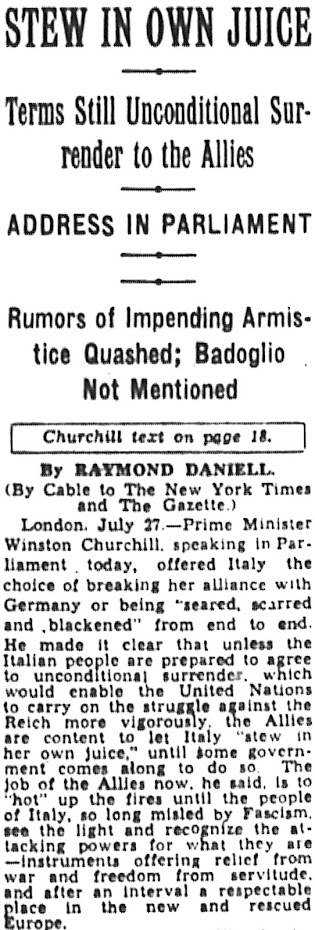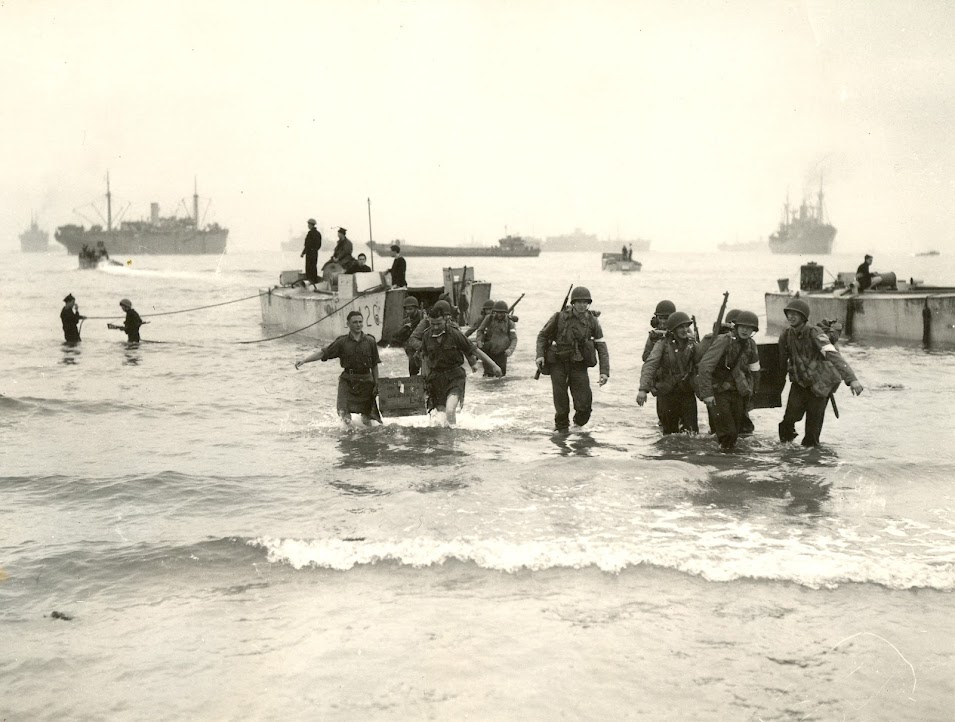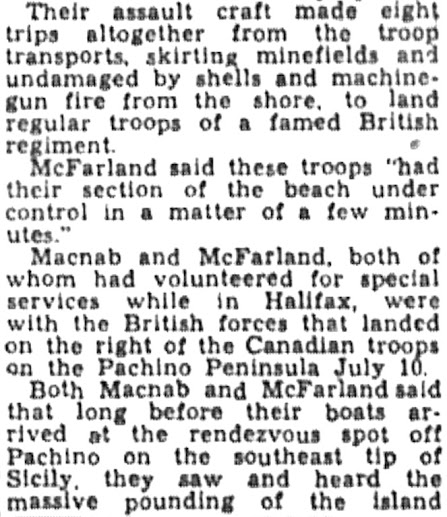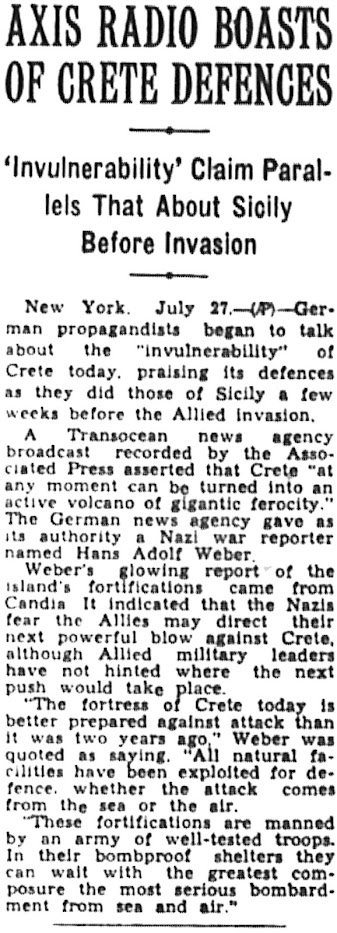Members of Canadian Army Scale Mount Etna Cliffs
Rare Item - Members of Canadian Navy are Interviewed
The 55th and 61st Canadian LCA Flotillas (Landing Craft Assault)
are back in England, many sailors enjoying a pint. (The 80th and 81st
are still delivering supplies to shores north of Avola). Map from
Combined Operations by Londoner Clayton Marks
Introduction:
Movement towards the successful outcome of military objectives - at least for the Allies in Sicily - is slow, gradual, costly and seemingly inevitable. Of course, we know how it all ends, but news stories of the day in July, 1943, continue to fill Canadian newspapers from coast to coast, and generally with something to cheer about.
Why, I even came across an article that mentions the actions of two Canadian landing craft flotillas (the 55th and 61st) during the opening days of Operation Husky, beginning on the east coast of Sicily on July 10th.
Here are the headlines (and much more) as found in The (Montreal) Gazette, the July 28 issue:
The German retreat from Sicily would include 1000s of tired, perhaps very lucky soldiers, excepting the ones pictured above, of course. More information about the German retreat can be found here.
Here are the headlines (and much more) as found in The (Montreal) Gazette, the July 28 issue:
Lionel Shapiro, war correspondent with The (Montreal) Gazette and with Canadian forces in central Sicily, reports on action two weeks before the German retreat from Sicily:
Photo 21083, from Album 61, Canadian Army Photo and Film Unit
Canadian and American forces fight "shoulder to shoulder" to break a savage German counterattack:
The article concludes with the following news: Spitfires and Lightnings based in Sicily get into the action, for the second time destroying "the enemy's aerial troop trains:
It's 'unconditional surrender or else' says Churchill:
More news from the front page of the July 28th edition:
More news from the foot-weary Lionel Shapiro:
The "foot-weary Lionel Shapiro" pecks away at his portable typewriter
Photo 22817 from Album 61, CAPFU 1943
L. Shapiro's news article continues with a description of "one of the most emotional experiences of my life:"
Emotions begin to run high in Palermo as the notion of freedom sinks in:
Canadian war correspondent Ross Munro writes another detailed account of action in Sicily:
"Troops in towns saw civilians celebrating the fall of the Duce with bottles of wine..."
R. Munro at work. Photo 22816 from Album 61, Canadian Army Photo and Film Unit
And now a few details about Canadian sailors in Combined Operations, in this case two members of the 55th and 61st Flotilla of Canadian Landing Craft, having completed the job of landing British troops (Monty's Eighth Army) on the southeast coast of Sicily during Operation HUSKY beginning July 10, 1943.
Map re invasion of Sicily from Combined Operations by Londoner Clayton Marks
Landings of Canadian Landing Craft Assault, see lower right corner
Combined Operations shoulder patch, a gift to me from Jim Jepson
of Furnace, Scotland (a few miles south of Inveraray)
A few details follow re 100 - 200 Canadian "Combined-Operations personnel" and landings in North Africa:
Combined Ops insignia as found on front cover of Combined Operations by Clayton Marks
Canadian sailors landed British and American troops of the Center Task Force
and British forces of the Eastern Task Force beginning Nov. 8, 1942
Canadian sailors, including my father Doug Harrison, landed U.S. Rangers
and supplies at R and Z Beach, near Arzew, "in sight of a cafe. Good reconn,"
writes my father. Map found on page 66, Combined Operations, C. Marks
Canadian sailor Doug Harrison (RCNVR, Combined Ops), center, welcomes
American troops ashore near Arzew during early days of Operation TORCH.
The Heading and Caption for the above photograph reads as follows:
Caption - A12671 Troops and ammunition for light guns being brought ashore from a landing craft assault (ramped) (LCA 428) on Arzeau beach, Algeria, North Africa, whilst another LCA (LCA 287) approaches the beach. RCN Photographer Lt. F. A. Hudson, Imperial War Museum (IWM)
craft's position) or enjoying a smoke aboard LCA 426, sitting astride a round object.
The caption for the photo reads as follows:
News article SICILY JOB TOUGH, SAILORS DECLARE continues below:
Major-General Guy Simonds (left), Canadian 1st Division, in Sicily, July,
1943. Photo 23681, Album 62, Canadian Army Photo and Film Unit
Major-General Guy Simonds (second right), in Sicily, July, 1943
Photo 23201, Album 62, Canadian Army Photo and Film Unit
As regular readers already know, I do not share many stories about individuals or their experiences in the army or air force - unless it has some connection to Canadians in Combined Ops or adds some context for the actions re those particular Canadians - because my focus is on the 950 - 1,000 sailors, like my father, who volunteered to join Comb. Ops and ultimately handled landing crafts on several foreign, distant shores. And that focus keeps me pretty busy.
That being said, not only is the incident mentioned in the short news clipping below very rare, it took place in an area of Ontario with which I am familiar. And the last name of the very fortunate pilot sounds familiar too. Simcoe - I played hockey against Simcoe and one of my early crushes lived there. Hagersville - I played hockey against that town's team as well (in the 1960s) and visited the wife of a Navy veteran at a long-term care facility there. Port Rowan - on Highway 59, as is my hometown of Norwich, Ontario. Pickersgill - didn't a Pickersgill attend the same high school as I did? Oh, I think so.
In other words, this story landed pretty close to home in more ways than one:
Below is a paragraph from an article re the Hagersville air school:
Between 1941 and March 30, 1945, 1,783 young men received their pilot’s wings at the Hagersville School and 16 died during training. The station remained operational until September 21, 1945. After the training school closed, the site – known as Camp Hagersville – was used by the Canadian Army for various purposes and was designated as No. 1 Vehicle Company, Central Mechanization Depot. The Camp was closed in 1964.
Accompanying photo:
Photo Credit - The History of Haldimand’s Military Aerial Schools
Please click here for more information about "two of the British flight training schools" (including Camp Hagersville.
Moving on: I have discovered that my father and some Navy mates played a lot of baseball at HMCS Givenchy III after returning home to Canada (several months after their three months in the Mediterranean had ended in October, 1943). Looks like WAC Diamondeers beat them to the ball park:
More information about women's baseball during WWII can be found here.
Find below news about the dangers faced by POWs as they are transported "out of the Mediterranean war zone":
The value and usefulness of U.S. Liberty ships during WWII cannot be understated:
When the 80th and 81st Canadian Flotillas of Landing craft were busy unloading supplies, i.e., all materials of war incl. troop reserves for Monty's Eighth Army on beaches scattered along the east coast of Sicily, e.g., south of Syracusa (at Fontana Bianca and Gallina, respectively), U.S. Liberty ships were indispensable.
Below is a map found in From St. Nazaire to Singapore: The Canadian Amphibious War, Volume 1, the first of 2 books of WWII veterans' stories (members of RCNVR/Combined Operations) inspired by Combined Operations by Londoner Clayton Marks. It reveals the landing craft unloading area (HOW Sector) for the 81st Flotilla of LCMs off the coast of Gallina (about 3 miles south of Fontana Bianca and GEORGE Sector, home zone for the 80th Flotilla of Landing Crafts). Many of the ships waiting to unload valuable supplies (fuel, ammunition, food, reserves, more fuel, ammunition, rations, more fuel, etc.) are U.S. Liberty ships, e.g., Big Foot Wallace, Mayo Brothers, O. Henry, G.H. Dern.
SHHH! "MOST SECRET" MAP!!
Ships are named, indicated as dark circles offshore, From A1, A2, A3.... to F3
RED, AMBER and GREEN (Gallina) BEACHES (81st Flotilla's zone)are under-
lined w black marker. 80th's sector (GEORGE) is upper right with dark outline.
Cities Noto and Avola are actually farther south. Two or three veterans (incl. my
father) write about the HMHS Talamba being sunk.
Write to Editor (Gord H.) at gordh7700@gmail.com for more details re HMHS (His Majesties Hospital Ship) Talamba.
The location of GEORGE and HOW Sectors can be seen more clearly on the following map of the lower east coast of Sicily (see Acid North):
The article "200 Liberty Ships Leased To Allies" continues below:
Mayo Brothers was launched by Delta Shipbuilding Co. in New Orleans.
Photo Credit - See and Hear: Museum Blog
In my reading experience, I have come across few examples of "British submarines operating in the Mediterranean" as addressed below:
More details about British submarine action in WWII can be found here: British Submarine Operations in World War II.
The British submarine HMS Thistle of T class, Group One. She was lost
on 10 April 1940 to German U-boat U-4. Photo Credit - uboat.net
More details re British Submarines can be found here: British Submarines of WWII
War correspondents Lionel Shapiro (center) and Ross Munro (right) were busy
for several months in the Mediterranean. Photo 22701, Album 62, CAPFU
Ross Munro "Mobbed by Overjoyed Sicilians" somewhere in Sicily, July 1943:
Meanwhile, back in the Pacific theatre of war...
Items related to WWII as found in The (Montreal) Gazette on Wednesday, July 28, 1943 conclude with a piece written by Scott Young (who eventually ended up in the Canadian Navy), father of Canadian singer-songwriter Neil Young:
More news clips to follow shortly.
Unattributed Photos GH



































.jpeg)





































No comments:
Post a Comment